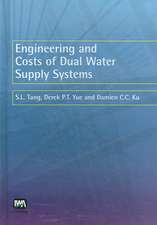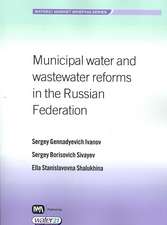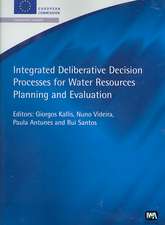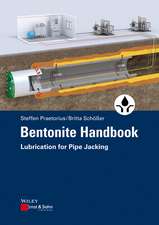Identifying and Communicating the Benefits and Risks of Disinfecting Wet Weather Flows: A Bench Scale Evaluation: Werf Research Report
Autor Pe Moffa, Brown and Caldwell, Syracuse Research Corporationen Limba Engleză Paperback – noi 2006
Din seria Werf Research Report
- 23%
 Preț: 838.43 lei
Preț: 838.43 lei - 23%
 Preț: 787.71 lei
Preț: 787.71 lei - 23%
 Preț: 785.57 lei
Preț: 785.57 lei - 23%
 Preț: 794.54 lei
Preț: 794.54 lei - 23%
 Preț: 794.07 lei
Preț: 794.07 lei - 23%
 Preț: 793.14 lei
Preț: 793.14 lei - 23%
 Preț: 961.96 lei
Preț: 961.96 lei - 23%
 Preț: 794.07 lei
Preț: 794.07 lei - 23%
 Preț: 813.50 lei
Preț: 813.50 lei - 23%
 Preț: 783.69 lei
Preț: 783.69 lei - 23%
 Preț: 812.10 lei
Preț: 812.10 lei - 23%
 Preț: 790.52 lei
Preț: 790.52 lei - 23%
 Preț: 805.93 lei
Preț: 805.93 lei - 23%
 Preț: 789.58 lei
Preț: 789.58 lei - 23%
 Preț: 804.05 lei
Preț: 804.05 lei - 23%
 Preț: 799.55 lei
Preț: 799.55 lei - 23%
 Preț: 800.50 lei
Preț: 800.50 lei - 23%
 Preț: 791.72 lei
Preț: 791.72 lei - 23%
 Preț: 787.23 lei
Preț: 787.23 lei - 23%
 Preț: 798.57 lei
Preț: 798.57 lei - 23%
 Preț: 791.26 lei
Preț: 791.26 lei - 23%
 Preț: 804.52 lei
Preț: 804.52 lei - 23%
 Preț: 790.52 lei
Preț: 790.52 lei - 23%
 Preț: 799.55 lei
Preț: 799.55 lei - 23%
 Preț: 787.71 lei
Preț: 787.71 lei - 23%
 Preț: 850.28 lei
Preț: 850.28 lei - 23%
 Preț: 796.48 lei
Preț: 796.48 lei - 23%
 Preț: 795.27 lei
Preț: 795.27 lei - 23%
 Preț: 965.23 lei
Preț: 965.23 lei - 23%
 Preț: 797.62 lei
Preț: 797.62 lei - 23%
 Preț: 976.62 lei
Preț: 976.62 lei - 23%
 Preț: 785.09 lei
Preț: 785.09 lei - 23%
 Preț: 970.20 lei
Preț: 970.20 lei - 23%
 Preț: 786.50 lei
Preț: 786.50 lei - 23%
 Preț: 795.95 lei
Preț: 795.95 lei - 23%
 Preț: 966.45 lei
Preț: 966.45 lei - 23%
 Preț: 796.48 lei
Preț: 796.48 lei - 23%
 Preț: 794.80 lei
Preț: 794.80 lei - 23%
 Preț: 958.87 lei
Preț: 958.87 lei - 23%
 Preț: 805.93 lei
Preț: 805.93 lei - 23%
 Preț: 806.40 lei
Preț: 806.40 lei - 23%
 Preț: 789.84 lei
Preț: 789.84 lei - 23%
 Preț: 792.19 lei
Preț: 792.19 lei - 23%
 Preț: 957.40 lei
Preț: 957.40 lei - 23%
 Preț: 796.68 lei
Preț: 796.68 lei - 23%
 Preț: 966.91 lei
Preț: 966.91 lei - 23%
 Preț: 964.77 lei
Preț: 964.77 lei - 23%
 Preț: 975.22 lei
Preț: 975.22 lei
Preț: 797.16 lei
Preț vechi: 1035.27 lei
-23% Nou
Puncte Express: 1196
Preț estimativ în valută:
152.53€ • 159.69$ • 126.21£
152.53€ • 159.69$ • 126.21£
Carte tipărită la comandă
Livrare economică 01-07 aprilie
Preluare comenzi: 021 569.72.76
Specificații
ISBN-13: 9781843397090
ISBN-10: 1843397099
Pagini: 172
Ilustrații: 1
Dimensiuni: 210 x 279 x 9 mm
Greutate: 0.4 kg
Editura: IWA Publishing (Intl Water Assoc)
Seria Werf Research Report
Locul publicării:United Kingdom
ISBN-10: 1843397099
Pagini: 172
Ilustrații: 1
Dimensiuni: 210 x 279 x 9 mm
Greutate: 0.4 kg
Editura: IWA Publishing (Intl Water Assoc)
Seria Werf Research Report
Locul publicării:United Kingdom













